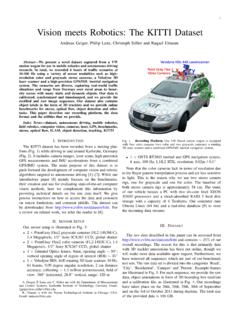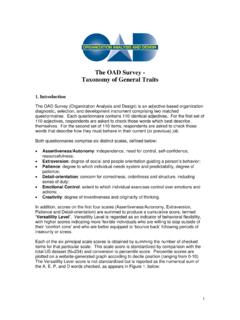Transcription of Using Instantaneous BLM Results to Make Site-Specific ...
1 THE fixed monitoring benchmark (FMB) approach . or ific Decisions Using Instantaneous BLM Results to make Site-Spec tional hardness-dependent water quality Biotic ligand model (BLM)-based criteria and the tradi criteria (WQC) are both time variable. -based criteria typically exhibit much However, Colorado datasets have indicated that BLM. tes the identification of a single value greater variability compared to WQC, which complica ions. for the purpose of making assessment and permit decis support the use of any sort of average For example, CDPHE and EPA have been reluctant to criteria, because of concern that it value to represent the distribution of BLM Instantaneous y exceedances).
2 Would be under protective of aquatic life ( , too man value, fQgiven situation, that achieves The basic idea of the FMB is to identify the single the new EPA BLM-copper criteria. the same exceedance frequency (once in three years) as uce the same exceedence frequency as In other words, the FMB is a single value that will prod lated Using the BLM, when the time variable distribution of Instantaneous criteria calcu ents. compared to a given set of ambient copper measurem is that FMB are calculated, in part, One of the major differences between FMB and WQC (whether Using the BLM a distribution of ambient Cu concentrations, whereas WQC.))
3 The water quality char acteristics hardness-dependent or BLM-based) are calculated Using 2P11.. of the receiving water, independent of Cu concentrations ibution of toxic units (TU), calculated as: The FMB method requires knowledge of the distr (Cu TUi =. IWQC, TU is the number of toxic units for the sample where: 1. 1 is the Cu concentration in the sample, and Cu IWQC is the BLM-based Instantaneous WQC. 1. ber of ambient samples where both the As such, the FMB method requires an adequate num ability BLM input parameters the measured Cu concentration are known, so that the prob ofcriteria exceedance can be characterized. sed analysis of an ambient dataset to Key point The FMB method uses a probability-ba achieves the desired exceedance - identify a single copper benchmark concentration that ria exceedances have been observed.
4 Frequency. The method can be used whether or not crite od to Colorado datasets are described in Details and Results from application of the FMB meth the October 10, 2008 Hydroqual report. Prepared by HydroQual, Inc. for the US Environmental Protection Agency Calculation of BLM fixed monitoring Benchmarks for Copper at Selected monitoring Sites in Colorado Final Report October 10, 2008..001. Hydroqual's report and appendices can be downloaded from: Colorado CuBLM_ImpIemtfinalreport2008j0 10 pdf (51 pgs, saze 2,109,980). ColoradoCuBLMI mplemtAppendicestDH pdf (450 pgs, size = 10 122,880). _____. STATE OF COLORADO. Bill Owens, Governor Douglas H.
5 Benevento, Executive Director nment of the people of Colorado Dedicated to protecting and improving the health and enviro 4300 Cherry Creek Dr. S. Laboratory Services Division Denver, Colorado 80246-1530 8100 Lowry Blvd. Phone (303) 692-2000 Denver, Colorado 80230-6928. TDD Line (303) 691-7700 (303) 692-3090 Colorado Department Located in Glendale, Colorado of Public Health and Environment Date: October 13, 2005. To: Permits Unit From: Andrew Ross RE: Biotic Ligand Model Introduction n's ( Division's ) informal guidance on the use of This memo is intended to be the Water Quality Control Divisio for dissolved copper. EPA's Biotic Ligand Model ( BLM ) to establish water effect ratios BLM Background y is related to dissolved metals binding to a The Biotic Ligand Model ( ELM ) is based on the premise that toxicit sm is related to both the concentration of the biochemical site (such as a fish gill).
6 That binding to the organi water that compete for the metal. Complexing metal in the water and the amount of complexing ligands in the the bioavailablity of the metal, and ligands, such as dissolved organic carbon and other constituents, reduce 2003 Draft Update ofAmbient Water Quality reduce the toxic effect. Use of the BLM is described in EPA's BLM can be found on EPA's website at Criteria for Copper (EPA 822-R-03-026). The criteria document and !copper/. Appropriate Use of the BLM. t ated or effluent influenced streams and The Division believes that the BLM is only appropriate in effluen domin ial sources). For example, the BLM was rivers (effluent meaning from municipal sources as opposed to industr pal water treatment plants.
7 In order to apply a applied to streams in the Denver Metro Area below major munici WER needs to be presented to the Water water effects ratio ( WER ) to a dissolved copper standard, the BLM. Quality Control Commission through the water quality standards review process with adequate documentation of the data and any assumptions made in Using the model. lenient effluent limits in a CDPS permit. The The use of the BLM to develop WERs may not result in more ping effluent limits. Division must take into account downstream water uses when develo Data Collection conducting a BLM study, but is willing to make The Division does not approve or disapprove sampling plans for ,nfunnai comments on a plan.
8 S taken above the waster water treatment facility In general, the Division recommends that water quality sample be should be at a downstream distance where full ( WWTF ) and below the WWTF. The samples below the WWTF. segme nts that are longer than five miles, the mixing of the effluent and stream water has occurred. For stream Division recommends that more than one downstream sampling site be used. For stream segments with more than one NPDES permit (excluding stormwater and construction dewatering permit s), samples should be taken below each NPDES permit discharge. The water quality data must adequately describe the seasonal attributes of the stream.
9 Recognizing that each stream and WWTF is unique in Colorado, the Division is not issuing formal guidelines on the amount of data needed to effectively utilize the BLM at this time. However, the Division recomm ends that a BLM WER study have at least one year of water quality data with a minimum of 24 sample events . The Division does not recommend synthesizing data by regression analysis Using parameters from past sampling events. Table I lists the Division's routine sample panel and the parameters needed to run the BLM. It is not necessary to collect humic acid data to effectively run the BLM, although the Divisio n encourages the collection of huinic acid data as levels of humic acid in Colorado streams is generally not known.
10 The Division strongly encourages that water quality data that will likely be used in a water quality standards hearing before the Water Quality Control Commission be migrated into EPA's STORET database. Contacts Biotic Ligand Model: Andrew Ross 303-692-3540 or Sarah Johnson 303-692-3609. Water Quality Control Commission: Paul Frohardt 303-692-3468. STORET database: Ame Sjodin 303-692-3522. Table I. WQCD routine sample panel and BLM parameters needed to run the model.. WQCD Routine BLM BLM. Parameter Units Panel Parameters Importance Aluminum (dis) jig/I X. Arsenic (dis) jig/I X. Cadmium (dis) jig/I X. Copper (dis) jig/I X X High Hardness, Total (Ca and Mg) mg/I as CaCO3 X X High IRON, DIS.






![Abstract arXiv:1707.01836v1 [cs.CV] 6 Jul 2017](/cache/preview/4/1/7/c/3/c/f/5/thumb-417c3cf524207c81cbb20aac762ce5b4.jpg)
